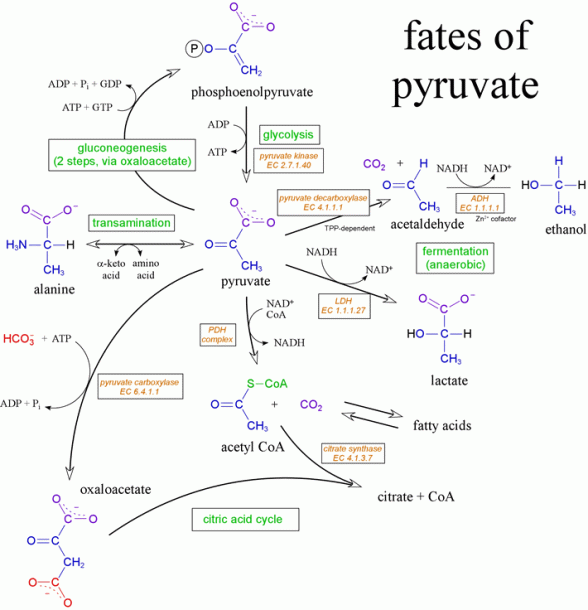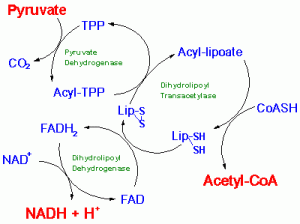In determining the fate of pyruvate after glycolysis, two questions need to be asked;
- 1. Is there oxygen present i.e. aerobic conditions?
- 2. Are there any mitochondria present to facilitate TCA cycle and ETC?
In aerobic conditions, with mitochondria present, the two molecules of pyruvate produced from one molecule of glucose, is then transported to the mitochondria of the cell where it enters the TCA cycle. Via the TCA and ETC, energy is then generated and NAD+ is regenerated in the ETC.
Pyruvate cannot readily enter the TCA cycle and therefore, must be converted to alternative compound. Pyruvate is converted to Acetyl-CoA in the matrix of the mitochondria by the enzyme PYRUVATE DEHYDROGENASE. Pyruvate dehydrogenase is an enzyme complex that consists of three subunits. It also requires five co-factors in order to effectively catalyse the conversion of pyruvate to Acetyl-CoA. These 5 co-factors are Co-A, TPP, lipoate, FAD and NAD+. During this process, there is loss of a carbon atom from pyruvate to form carbon dioxide. Additionally, NAD+ is reduced to NADH to facilitate the oxidation of pyruvate to acetyl-CoA. Hence, this reaction is an OXIDIZING DECARBOXYLATION.
At the end of the reaction, 2 molecules of pyruvate form 2 molecules of Acetyl Co-A + 2 molecules of carbon dioxide + NADH. This reaction is also IRREVERSIBLE. Once Acetyl CoA is formed, it is combined to oxaloacetate in the matrix of the mitochondria to form citrate in the TCA cycle. This occurs in plant, animal and some microbial cells with the essential requirement that aerobic conditions exist and mitochondria are present.
Pyruvate may also be converted to oxaloacetate, which also enters the TCA cycle to generate energy. This reaction is catalysed by the enzyme, PYRUVATE CARBOXYLASE that is dependent on biotin. Pyruvate undergoes a carboxylation reaction to form oxaloacetate. This is an essential process to replenish the intermediates of the TCA cycle and provide substrates for gluconeogenesis
In anaerobic conditions and in the absence of mitochondria, Fermentation reactions occur. Fermentation may occur by two methods, which result in either the formation of ethanol or lactic acid. The main purpose of fermentation is to regenerate the limited supply of NAD+ in the cell to continue reactions including glycolysis
In yeast cells, fermentation occurs in two steps. 2 molecules of pyruvate are converted to two molecules of ethanol and 2 molecules of carbon dioxide. Firstly, pyruvate is converted to acetaldehyde by the enzyme, PYRUVATE DECARBOXYLASE. This enzyme utilizes similar co factors to pyruvate dehydrogenase such as TPP, but may also utilize magnesium ions. In this decarboxylation, there is the release of carbon dioxide. This is an IRREVERSIBLE REACTION. Acetaldehyde is then converted to ethanol via ALCOHOL DEHYDROGENASE. During this process, NADH is oxidized to NAD+ and thus, performs a REDOX reaction. This reaction is reversible, however.
Funny enough, alcohol dehydrogenase is found in hepatocytes and aid in the metabolism of ethanol/alcohol after consumption. This enzyme also exists as isoforms, which is mutated in Asians and people of Asian ethnicity. This means that there is defective functioning of alcohol dehydrogenase and thus these people cannot metabolize alcohol quickly and suffer the toxic effects of alcohol quickly.
Fermentation may also occur in human cells under certain conditions. During vigorous exercising, skeletal muscles are unable to obtain an adequate supply of oxygen and therefore there are states of anoxia where the muscles have to undergo anaerobic respiration. In these circumstances, skeletal muscle undergoes fermentation to convert pyruvate to lactate. This process is essential to replenish the supply of NAD+ in order to ensure that glycolysis continues. However, lactic acid is toxic to cells since it causes a change in the pH and leads to acidosis.
In this fermentation reaction, pyruvate is converted to lactate by the enzyme, LACTATE DEHYDROGENASE. This is a slightly reversible reaction. During this process, NADH is oxidized to NAD+, which facilitates the reduction of pyruvate to lactate. Fermentation to form lactic acid also occurs in erythrocytes. Red blood cells lack mitochondria and therefore is unable to carry out TCA cycle and ETC, thus it relies on glycolysis for energy generation. This means that lactate is produced to ensure the quick regeneration of NAD+ to continue the glycolytic pathway.





